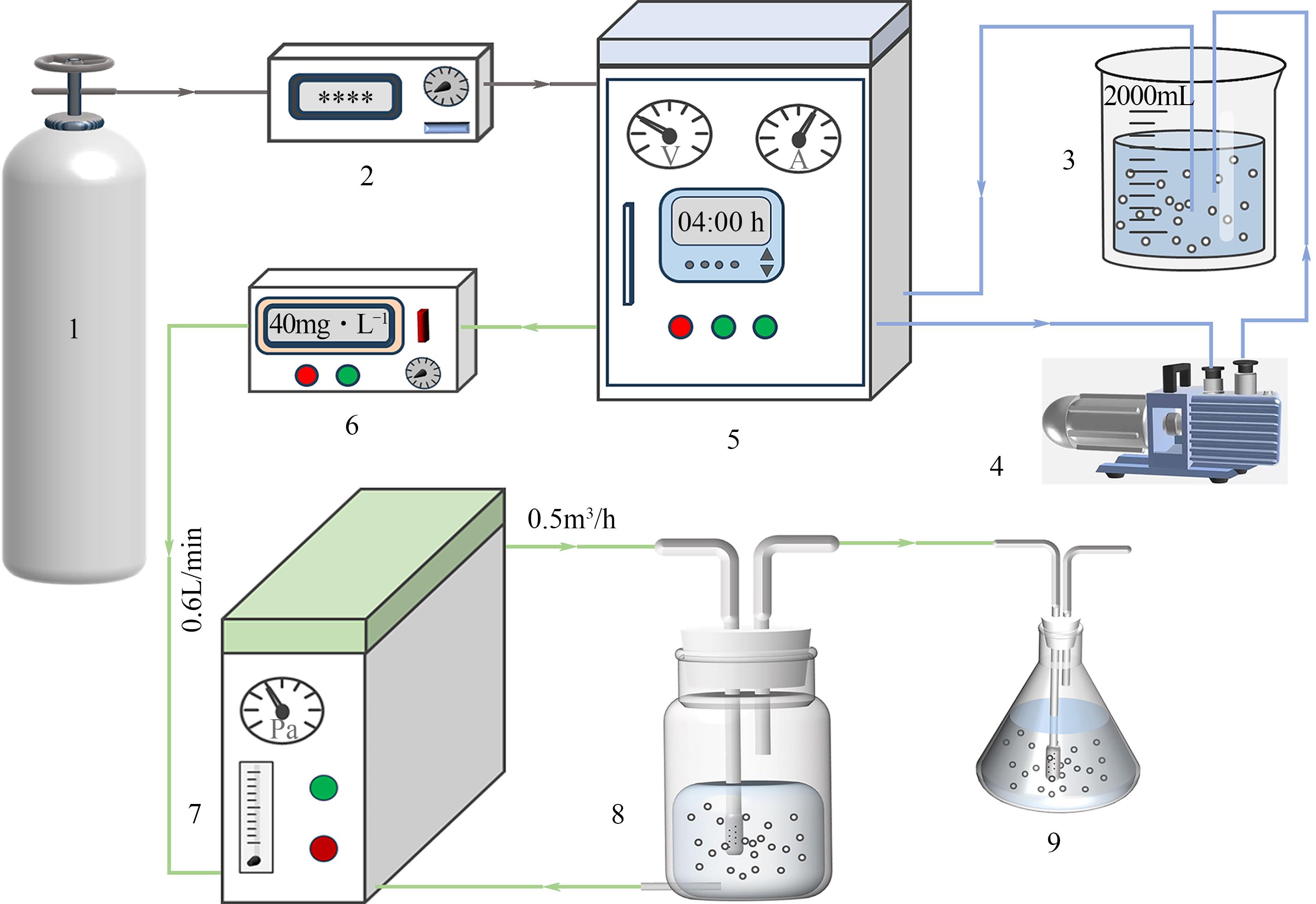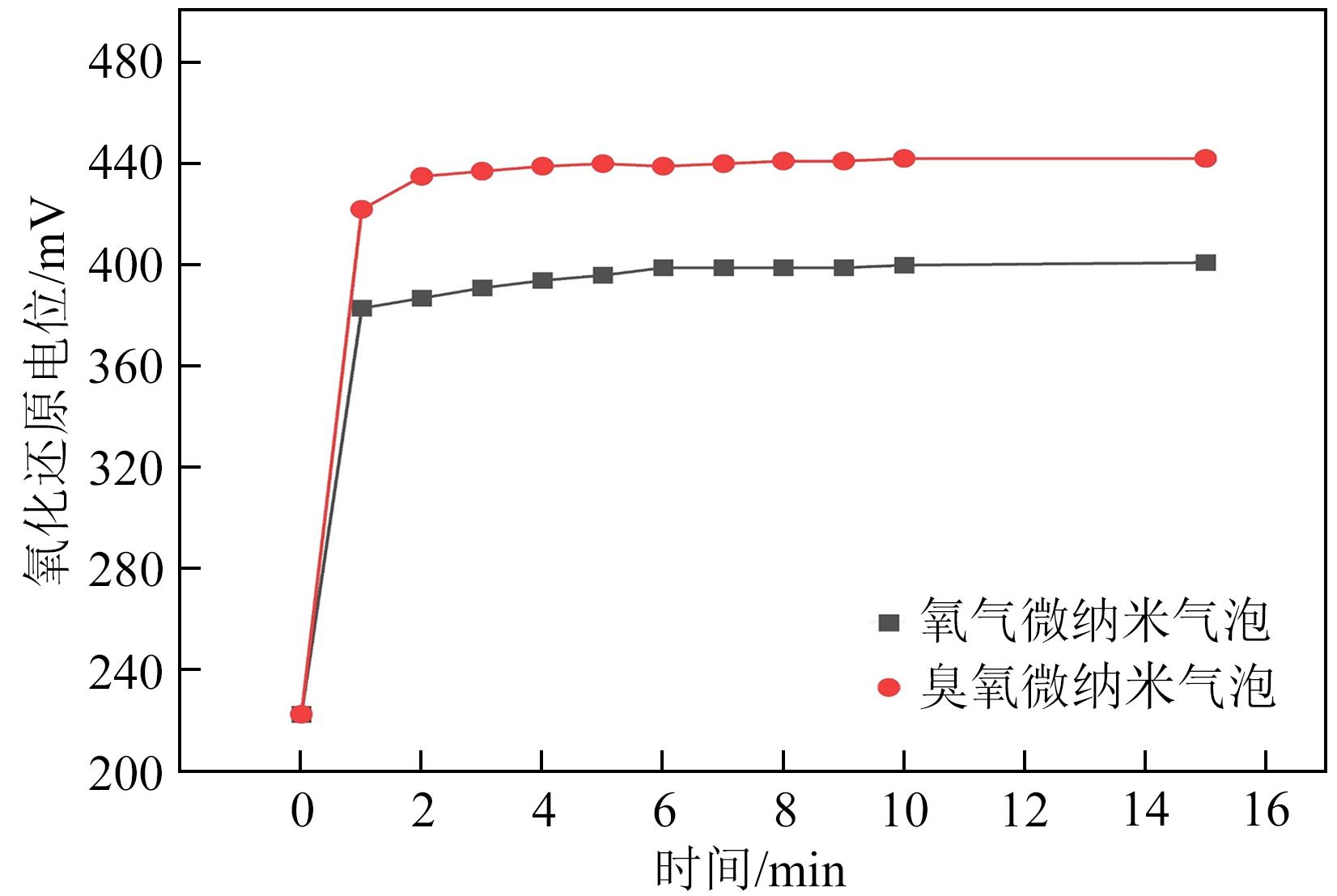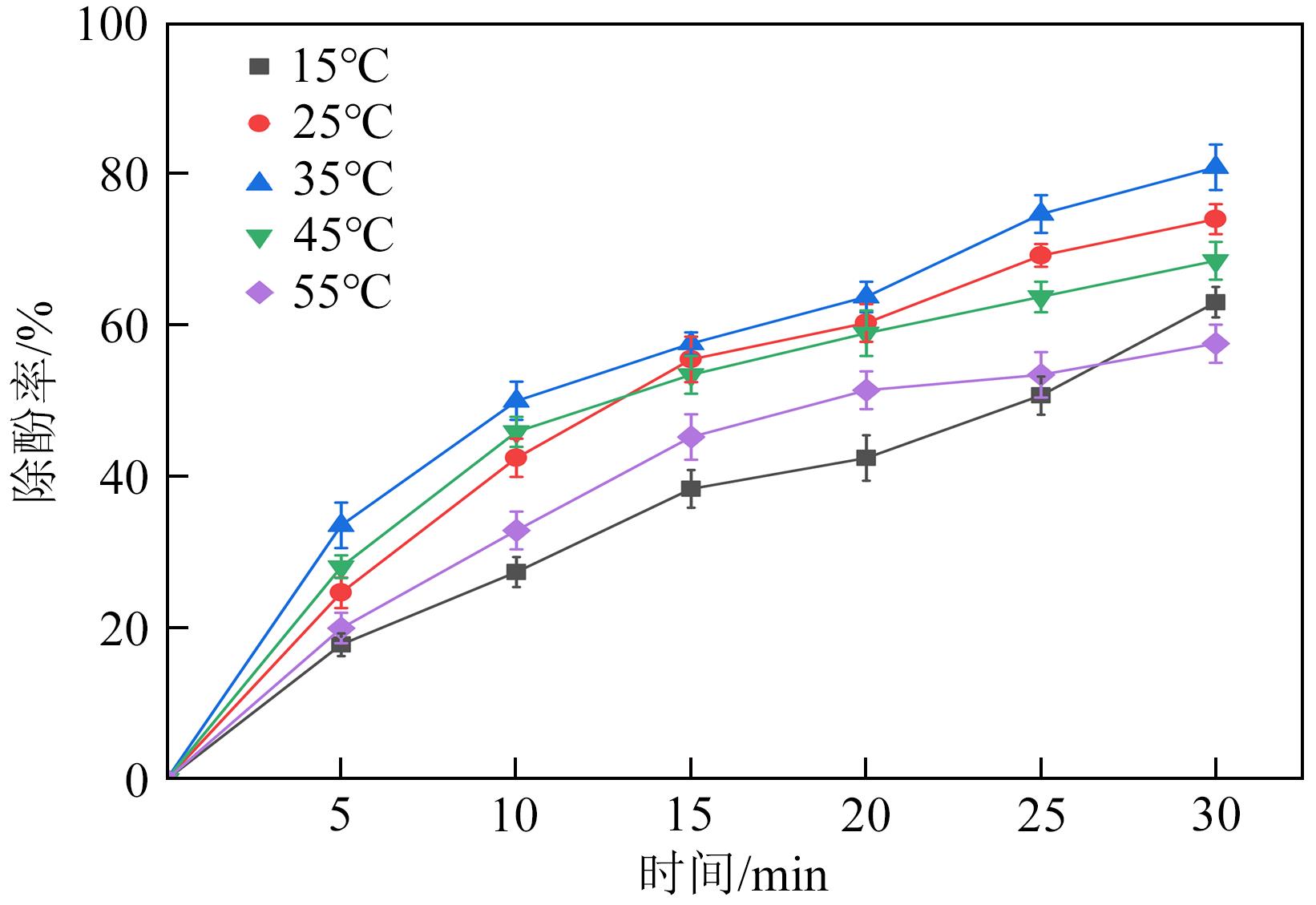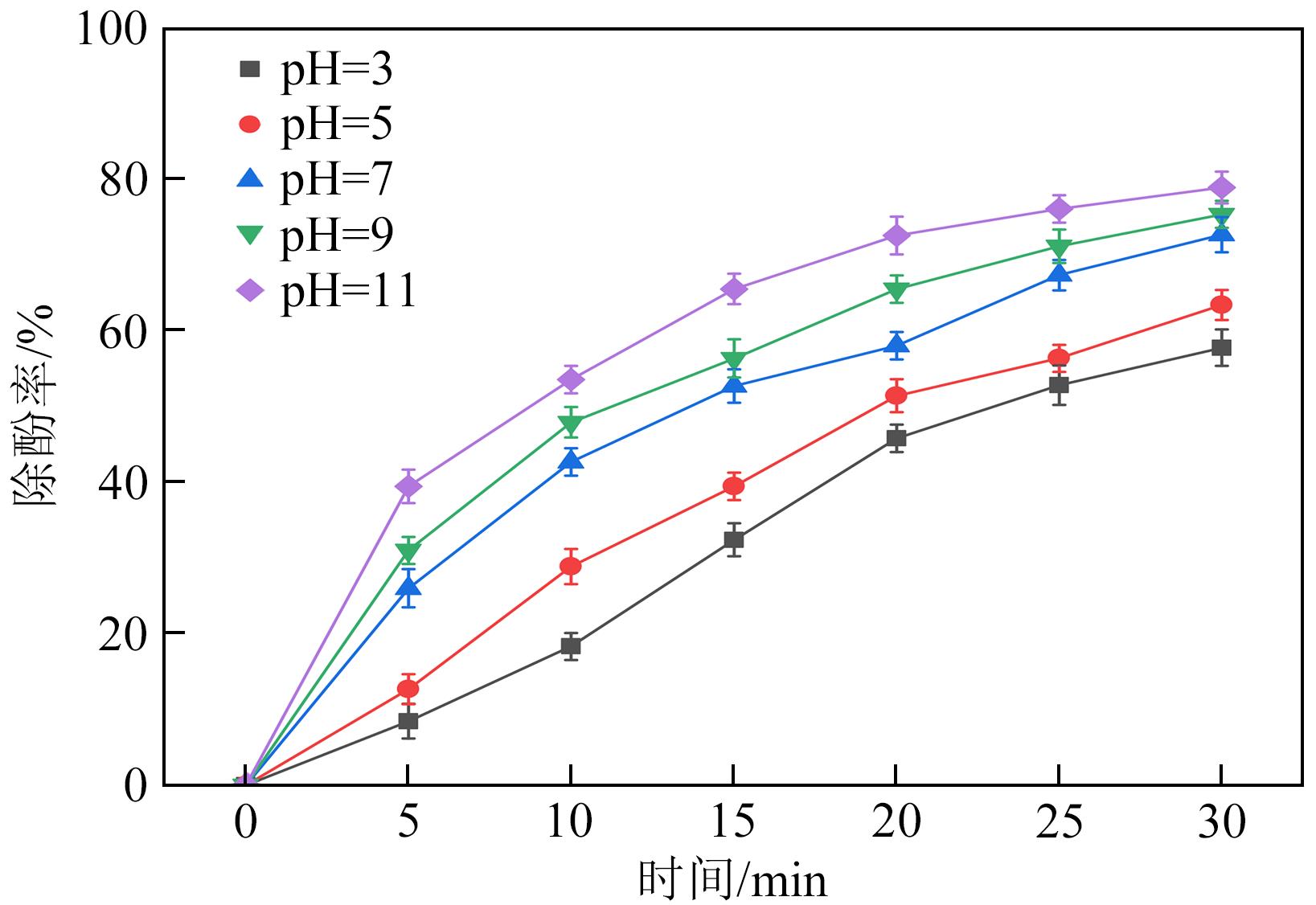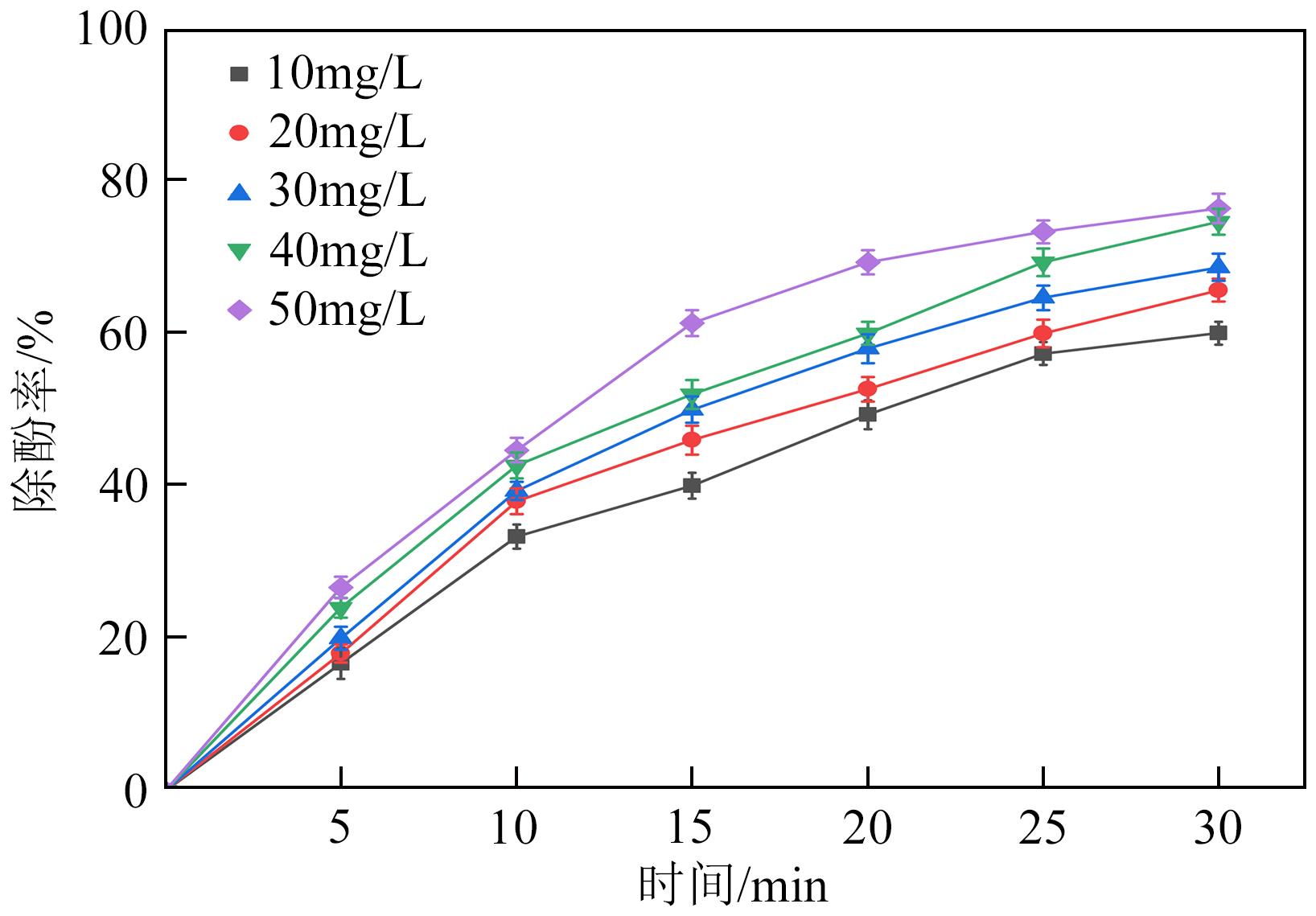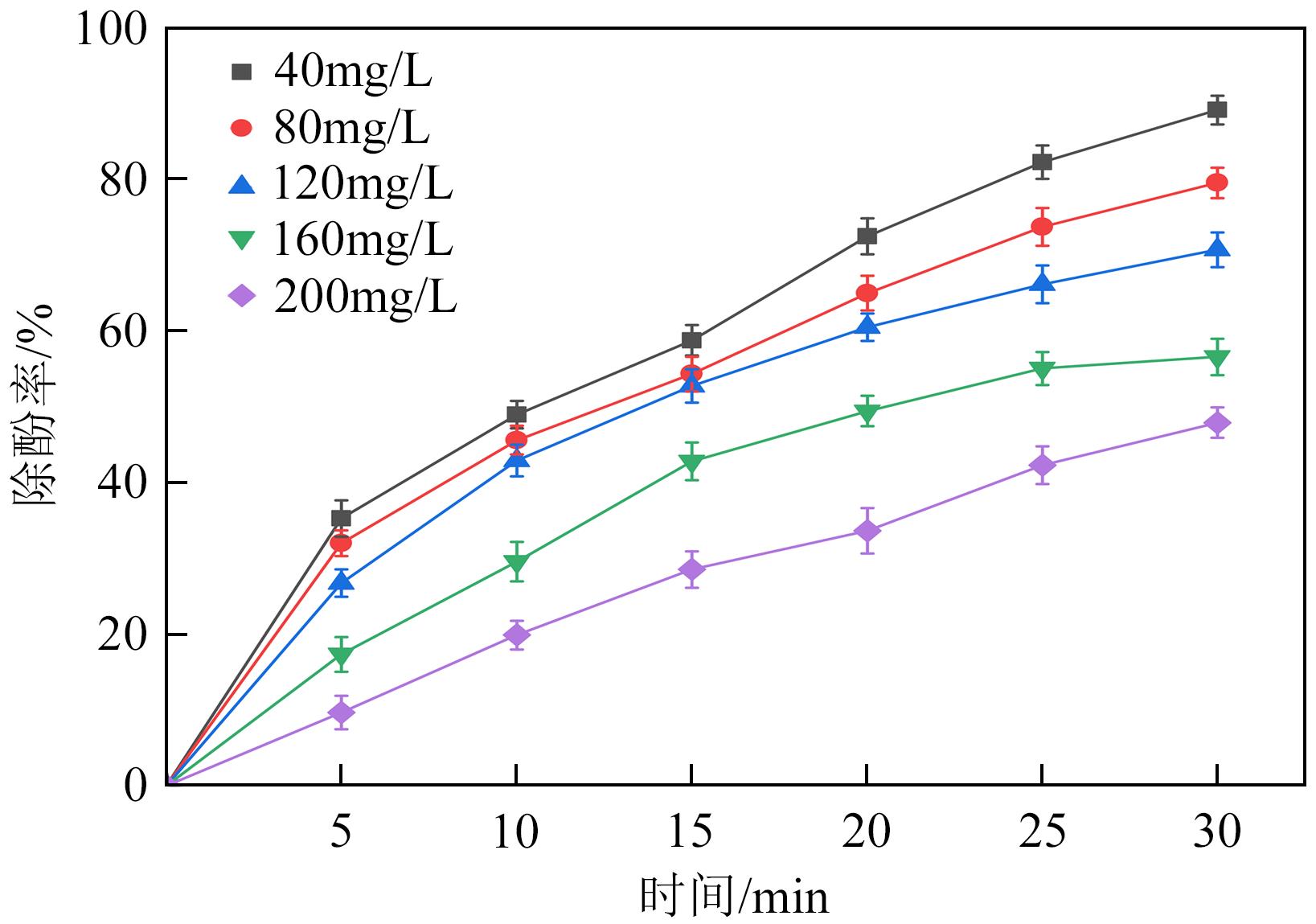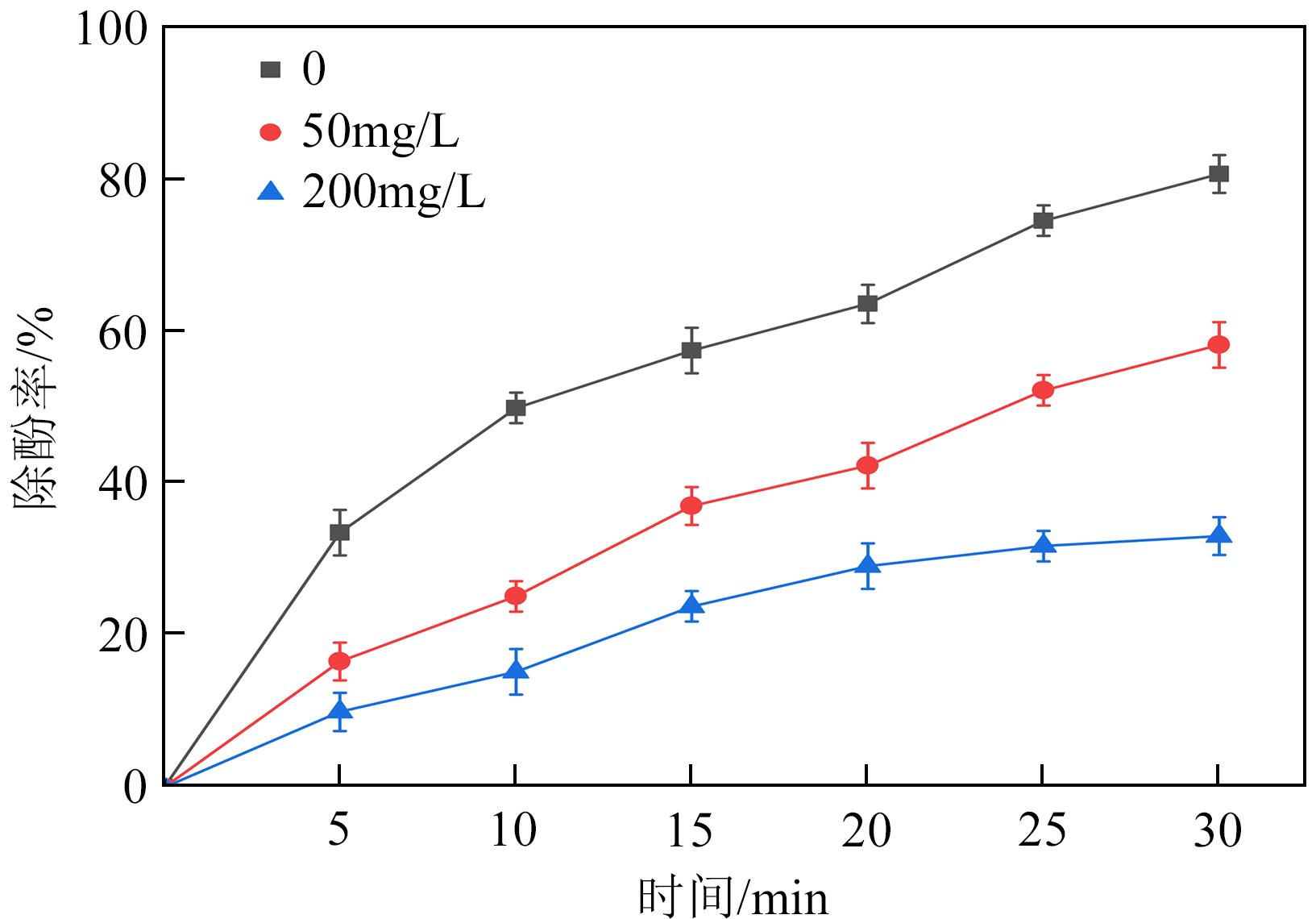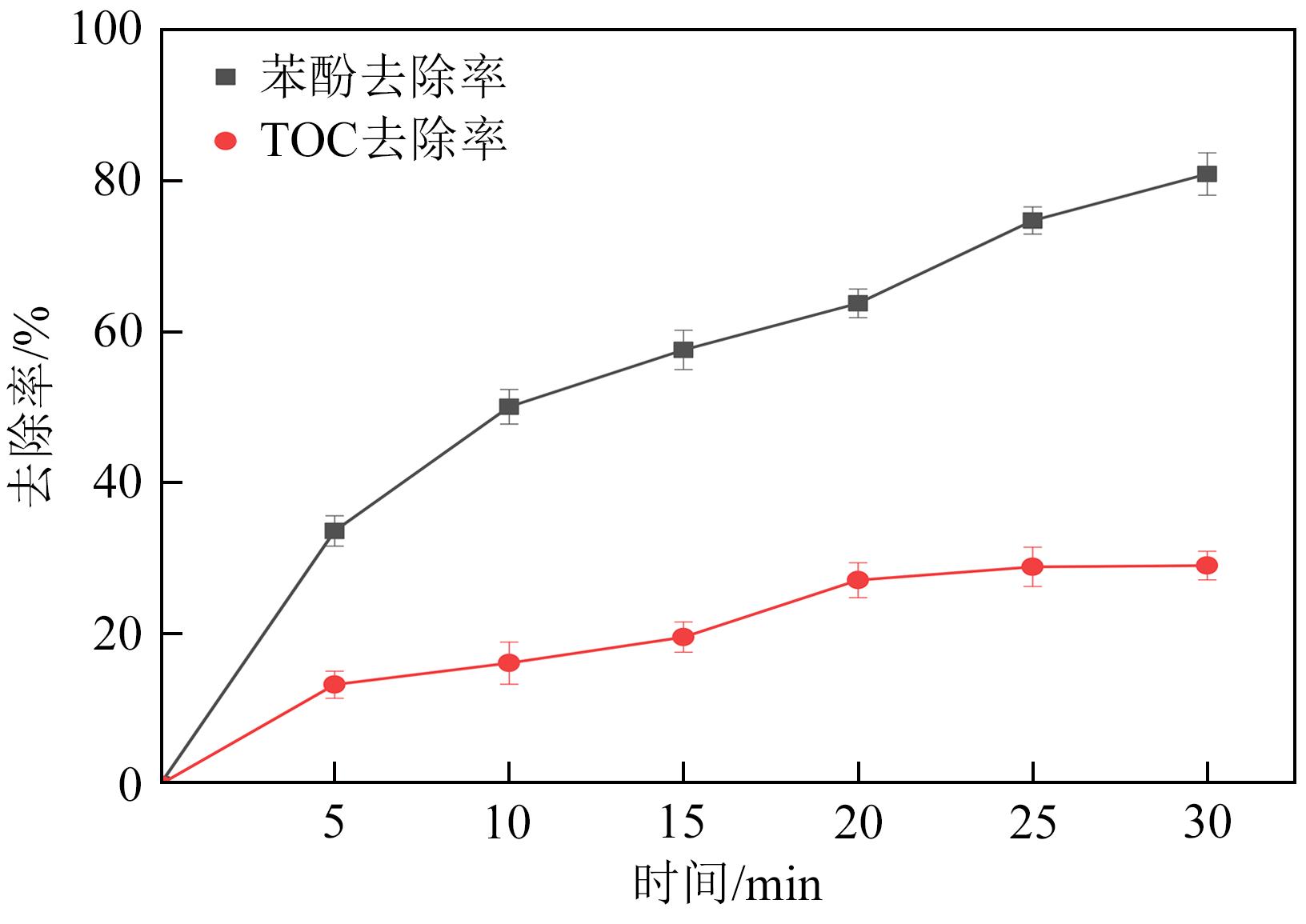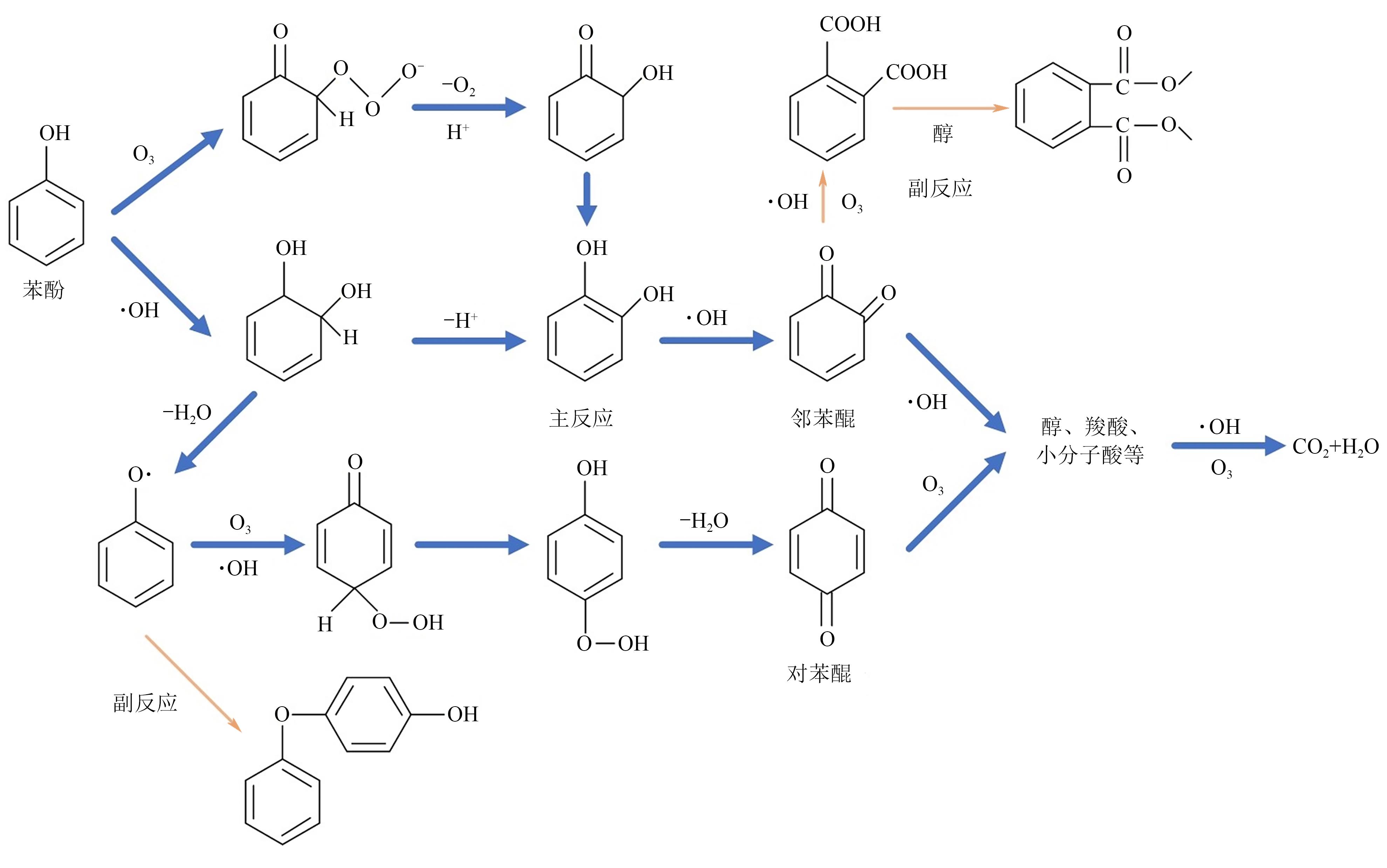Chemical Industry and Engineering Progress ›› 2024, Vol. 43 ›› Issue (8): 4614-4623.DOI: 10.16085/j.issn.1000-6613.2023-1249
• Resources and environmental engineering • Previous Articles
Micro-nano bubbles enhance ozone oxidation and degradation of wastewater containing phenol
SONG Zhanlong( ), TANG Tao, PAN Wei, ZHAO Xiqiang, SUN Jing, MAO Yanpeng, WANG Wenlong
), TANG Tao, PAN Wei, ZHAO Xiqiang, SUN Jing, MAO Yanpeng, WANG Wenlong
- National Engineering Laboratory of Coal Emission Reduction, Engineering Research Center of Environmental Thermal Technology Ministry of Education, Shandong Key Laboratory of Energy Carbon Emission Reduction Technology and Resource Utilization, Shandong University, Jinan 250061, Shandong, China
-
Received:2023-07-21Revised:2023-11-06Online:2024-09-02Published:2024-08-15 -
Contact:SONG Zhanlong
微纳米气泡强化臭氧氧化降解含酚废水
宋占龙( ), 汤涛, 潘蔚, 赵希强, 孙静, 毛岩鹏, 王文龙
), 汤涛, 潘蔚, 赵希强, 孙静, 毛岩鹏, 王文龙
- 山东大学燃煤污染物减排国家工程实验室,环境热工技术教育部工程研究中心,山东省能源碳减排技术与 资源化利用重点实验室,山东 济南 250061
-
通讯作者:宋占龙 -
作者简介:宋占龙(1977—),男,博士,教授,博士生导师,研究方向为固废资源化利用。E-mail:zlsong@sdu.edu.cn。 -
基金资助:山东省重大科技创新工程项目(2019JZZY020310)
CLC Number:
Cite this article
SONG Zhanlong, TANG Tao, PAN Wei, ZHAO Xiqiang, SUN Jing, MAO Yanpeng, WANG Wenlong. Micro-nano bubbles enhance ozone oxidation and degradation of wastewater containing phenol[J]. Chemical Industry and Engineering Progress, 2024, 43(8): 4614-4623.
宋占龙, 汤涛, 潘蔚, 赵希强, 孙静, 毛岩鹏, 王文龙. 微纳米气泡强化臭氧氧化降解含酚废水[J]. 化工进展, 2024, 43(8): 4614-4623.
share this article
Add to citation manager EndNote|Ris|BibTeX
URL: https://hgjz.cip.com.cn/EN/10.16085/j.issn.1000-6613.2023-1249
| 苯酚浓度/mg·L-1 | pH | 电导率/μS·cm-1 | 外观特性 |
|---|---|---|---|
| 40~200 | 7 | 698 | 无色透明 |
| 苯酚浓度/mg·L-1 | pH | 电导率/μS·cm-1 | 外观特性 |
|---|---|---|---|
| 40~200 | 7 | 698 | 无色透明 |
| 序号 | 物质名称及分子式 | 反应10min | 反应30min | ||
|---|---|---|---|---|---|
| 保留时间/min | 峰面积/×108 | 保留时间/min | 峰面积/×108 | ||
| 1 | 苯酚(C6H6O) | 5.83 | 96.6 | 5.65 | 19.40 |
| 2 | 邻苯二酚(C6H6O2) | 10.04 | 1.14 | 10.03 | 0.95 |
| 3 | 2,4-二甲基苯甲醛(C9H10O) | — | — | 10.25 | 1.00 |
| 4 | 邻苯二甲酸二甲酯(C10H10O4) | — | — | 14.46 | 0.25 |
| 5 | 2,4-二叔丁基酚(C14H22O) | 15.38 | 1.80 | 15.41 | 1.38 |
| 6 | 对苯氧基苯酚(C12H10O2) | — | — | 18.51 | 0.26 |
| 7 | 邻苯二甲酸二丁酯(C16H22O4) | 21.57 | 4.31 | 21.59 | 2.68 |
| 8 | 邻苯甲酸酯化物(C16H22O4) | — | — | 27.93 | 0.55 |
| 序号 | 物质名称及分子式 | 反应10min | 反应30min | ||
|---|---|---|---|---|---|
| 保留时间/min | 峰面积/×108 | 保留时间/min | 峰面积/×108 | ||
| 1 | 苯酚(C6H6O) | 5.83 | 96.6 | 5.65 | 19.40 |
| 2 | 邻苯二酚(C6H6O2) | 10.04 | 1.14 | 10.03 | 0.95 |
| 3 | 2,4-二甲基苯甲醛(C9H10O) | — | — | 10.25 | 1.00 |
| 4 | 邻苯二甲酸二甲酯(C10H10O4) | — | — | 14.46 | 0.25 |
| 5 | 2,4-二叔丁基酚(C14H22O) | 15.38 | 1.80 | 15.41 | 1.38 |
| 6 | 对苯氧基苯酚(C12H10O2) | — | — | 18.51 | 0.26 |
| 7 | 邻苯二甲酸二丁酯(C16H22O4) | 21.57 | 4.31 | 21.59 | 2.68 |
| 8 | 邻苯甲酸酯化物(C16H22O4) | — | — | 27.93 | 0.55 |
| 1 | DAI Shixiang, HARNISCH Falk, MOREJÓN Micjel Chávez, et al. Microbial electricity-driven anaerobic phenol degradation in bioelectrochemical systems[J]. Environmental Science and Ecotechnology, 2024, 17: 100307. |
| 2 | SUN Jianfei, MU Qin, KIMURA Hideo, et al. Oxidative degradation of phenols and substituted phenols in the water and atmosphere: A review[J]. Advanced Composites and Hybrid Materials, 2022, 5(2): 627-640. |
| 3 | BIBI Amina, BIBI Shazia, Mohammed ABU-DIEYEH, et al. Towards sustainable physiochemical and biological techniques for the remediation of phenol from wastewater: A review on current applications and removal mechanisms[J]. Journal of Cleaner Production, 2023, 417: 137810. |
| 4 | 齐亚兵. 活化过硫酸盐氧化法降解酚类污染物的研究进展[J]. 化工进展, 2022, 41(11): 6068-6079. |
| QI Yabing. Research progress on degradation of phenolic pollutants by activated persulfate oxidation[J]. Chemical Industry and Engineering Progress, 2022, 41(11): 6068-6079. | |
| 5 | LIU Xiaoning, YUAN Wenke, DI Mingxiao, et al. Transfer and fate of microplastics during the conventional activated sludge process in one wastewater treatment plant of China[J]. Chemical Engineering Journal, 2019, 362: 176-182. |
| 6 | JI Jing, GAO Tianpeng, SALAMA El-Sayed, et al. Using Aspergillus niger whole-cell biocatalyst mycelial aerobic granular sludge to treat pharmaceutical wastewater containing β-lactam antibiotics[J]. Chemical Engineering Journal, 2021, 412: 128665. |
| 7 | ZHANG Yi, Joo Hwa TAY. Alternated phenol and trichloroethylene biodegradation in an aerobic granular sludge reactor[J]. Biochemical Engineering Journal, 2016, 106: 1-10. |
| 8 | REN Longfei, Huu Hao NGO, BU Cuina, et al. Novel external extractive membrane bioreactor (EMBR) using electrospun polydimethylsiloxane/polymethyl methacrylate membrane for phenol-laden saline wastewater[J]. Chemical Engineering Journal, 2020, 383: 123179. |
| 9 | Thet YEE, RATHNAYAKE Thusitha, VISVANATHAN Chettiyappan. Performance evaluation of a thermophilic anaerobic membrane bioreactor for palm oil wastewater treatment[J]. Membranes, 2019, 9(4): 55. |
| 10 | SU Xiaomei, WANG Yuyang, XUE Binbing, et al. Impact of resuscitation promoting factor (Rpf) in membrane bioreactor treating high-saline phenolic wastewater: Performance robustness and Rpf-responsive bacterial populations[J]. Chemical Engineering Journal, 2019, 357: 715-723. |
| 11 | TONG Kun, ZHANG Yihe, LIU Guohua, et al. Treatment of heavy oil wastewater by a conventional activated sludge process coupled with an immobilized biological filter[J]. International Biodeterioration & Biodegradation, 2013, 84: 65-71. |
| 12 | WANG Chunhua, PENG Zhongli, FENG Kejun, et al. A study on the treatment efficiency of internal circulation biological aerated filters for refinery wastewater and the transformation of main organic pollutants[J]. Environmental Science and Pollution Research, 2020, 27(18): 22902-22912. |
| 13 | REN Wuang, CAO Fengfeng, CHAI Beibei, et al. Enhancing nitrogen removal from domestic sewage with low C/N ratio using a biological aerated filter system with internal reflux-coupled intermittent aeration[J]. Biochemical Engineering Journal, 2022, 185: 108532. |
| 14 | WANG Bin, CAO Xuefei, YU Shixin, et al. New sustainable Mannich-functionalized lignin flocculants for ultra-efficiently tailoring wastewater purification[J]. Journal of Cleaner Production, 2023, 387: 135801. |
| 15 | Kai Soon LIM, SETHU Vasanthi, SELVARAJOO Anurita. Natural plant materials as coagulant and flocculants for the treatment of palm oil mill effluent[J]. Materials Today: Proceedings, 2022, 48: 871-887. |
| 16 | YOU Zhaoyang, XU Haiyang, SUN Yongjun, et al. Effective treatment of emulsified oil wastewater by the coagulation-flotation process[J]. RSC Advances, 2018, 8(71): 40639-40646. |
| 17 | LI Yu, WU Luchao, WANG Yun, et al. γ-Al2O3 doped with cerium to enhance electron transfer in catalytic ozonation of phenol[J]. Journal of Water Process Engineering, 2020, 36: 101313. |
| 18 | 朱昊, 刘汉飞, 季雨凡, 等. 催化臭氧化处理酚类化合物的研究进展与机理解析[J]. 化工进展, 2022, 41(S1): 545-555. |
| ZHU Hao, LIU Hanfei, JI Yufan, et al. Research advance and mechanism analysis of catalytic ozonation of phenolic compounds[J]. Chemical Industry and Engineering Progress, 2022, 41(S1): 545-555. | |
| 19 | BARLAK Melahat Semin, Nejdet DEĞERMENCI, İbrahim CENGIZ, et al. Comparison of phenol removal with ozonation in jet loop reactor and bubble column[J]. Journal of Environmental Chemical Engineering, 2020, 8(5): 104402. |
| 20 | 王吉坤, 李阳, 陈贵锋, 等. 臭氧催化氧化降解煤化工生化进水有机物的实验及机理[J]. 化工进展, 2021, 40(10): 5837-5844. |
| WANG Jikun, LI Yang, CHEN Guifeng, et al. Experimental and mechanism studies on degradation of the organics in biochemical influent of coal chemical industry by ozone catalytic oxidation[J]. Chemical Industry and Engineering Progress, 2021, 40(10): 5837-5844. | |
| 21 | 蒋博龙, 史顺杰, 蒋海林, 等. 金属有机框架材料吸附处理苯酚污水机理研究进展[J]. 化工进展, 2021, 40(8): 4525-4539. |
| JIANG Bolong, SHI Shunjie, JIANG Hailin, et al. Research progress in phenol adsorption mechanism over metal-organic framework from wastewater[J]. Chemical Industry and Engineering Progress, 2021, 40(8): 4525-4539. | |
| 22 | KARAKULSKI Krzysztof, GRYTA Marek. The application of ultrafiltration for treatment of ships generated oily wastewater[J]. Chemical Papers, 2017, 71(6): 1165-1173. |
| 23 | WANG Yang, WANG Jianqiang, DING Yajie, et al. In situ generated micro-bubbles enhanced membrane antifouling for separation of oil-in-water emulsion[J]. Journal of Membrane Science, 2021, 621: 119005. |
| 24 | BEHIN J, BAHRAMI S. Modeling an industrial dissolved air flotation tank used for separating oil from wastewater[J]. Chemical Engineering and Processing: Process Intensification, 2012, 59: 1-8. |
| 25 | PAINMANAKUL P, SASTARAVET P, LERSJINTANAKARN S, et al. Effect of bubble hydrodynamic and chemical dosage on treatment of oily wastewater by induced air flotation (IAF) process[J]. Chemical Engineering Research and Design, 2010, 88(5/6): 693-702. |
| 26 | 陈二军, 张玉玲, 路少磊, 等. 空气纳米气泡的稳定性及理化特性[J]. 化工进展, 2022, 41(9): 4673-4681. |
| CHEN Erjun, ZHANG Yuling, LU Shaolei, et al. Stability and physicochemical properties of air nanobubbles[J]. Chemical Industry and Engineering Progress, 2022, 41(9): 4673-4681. | |
| 27 | SEDDON James R T, LOHSE Detlef, DUCKER William A, et al. A deliberation on nanobubbles at surfaces and in bulk[J]. Chemphyschem: A European Journal of Chemical Physics and Physical Chemistry, 2012, 13(8): 2179-2187. |
| 28 | 杨童, 谭嘉怡, 王燕, 等. 臭氧微纳米气泡对大肠杆菌的消毒效果及灭活机制[J]. 中国给水排水, 2022, 38(7): 1-10. |
| YANG Tong, TAN Jiayi, WANG Yan, et al. Disinfection effect and inactivation mechanism of ozone micro-nano bubbles on Escherichia coli [J]. China Water & Wastewater, 2022, 38(7): 1-10. | |
| 29 | REHMAN Fahad, MEDLEY Gareth J D, BANDULASENA Hemaka, et al. Fluidic oscillator-mediated microbubble generation to provide cost effective mass transfer and mixing efficiency to the wastewater treatment plants[J]. Environmental Research, 2015, 137: 32-39. |
| 30 | TAKAHASHI Masayoshi, CHIBA Kaneo, LI Pan. Free-radical generation from collapsing microbubbles in the absence of a dynamic stimulus[J]. The Journal of Physical Chemistry B, 2007, 111(6): 1343-1347. |
| 31 | HARIS Sabeera, QIU Xiaobin, KLAMMLER Harald, et al. The use of micro-nano bubbles in groundwater remediation: A comprehensive review[J]. Groundwater for Sustainable Development, 2020, 11: 100463. |
| 32 | ZHENG Tianlong, WANG Qunhui, SHI Zhining, et al. Separation of pollutants from oil-containing restaurant wastewater by novel microbubble air flotation and traditional dissolved air flotation[J]. Separation Science and Technology, 2015, 50(16): 2568-2577. |
| 33 | YE Shanshan, GENG Jianxin, ZHANG Haichuan, et al. Boosting oxygen diffusion by micro-nano bubbles for highly-efficient H2O2 generation on air-calcining graphite felt[J]. Electrochimica Acta, 2023, 439: 141708. |
| 34 | POH P E, ONG W Y J, LAU E V, et al. Investigation on micro-bubble flotation and coagulation for the treatment of anaerobically treated palm oil mill effluent (POME)[J]. Journal of Environmental Chemical Engineering, 2014, 2(2): 1174-1181. |
| 35 | LIU Yanan, ZHANG Han, SUN Jihui, et al. Degradation of aniline in aqueous solution using non-thermal plasma generated in microbubbles[J]. Chemical Engineering Journal, 2018, 345: 679-687. |
| 36 | SUN Zhiyi, XIA Fujun, LOU Ziyang, et al. Innovative process for total petroleum hydrocarbons reduction on oil refinery sludge through microbubble ozonation[J]. Journal of Cleaner Production, 2020, 256: 120337. |
| 37 | SHEN Dongsheng, XIE Zeming, SHENTU Jiali, et al. Enhanced oxidation of aromatic hydrocarbons by ozone micro-nano bubble water: Mechanism and influencing factors[J]. Journal of Environmental Chemical Engineering, 2023, 11(3): 110281. |
| 38 | LIU Shu, WANG Qunhui, SUN Tichang, et al. The effect of different types of micro-bubbles on the performance of the coagulation flotation process for coke waste-water[J]. Journal of Chemical Technology & Biotechnology, 2012, 87: 206-215. |
| 39 | 杜明辉, 王勇, 高群丽, 等. 臭氧微气泡处理有机废水的效果与机制[J]. 化工进展, 2021, 40(12): 6907-6915. |
| DU Minghui, WANG Yong, GAO Qunli, et al. Mechanism and efficiency of ozone microbubble treatment of organic wastewater[J]. Chemical Industry and Engineering Progress, 2021, 40(12): 6907-6915. | |
| 40 | HOU Sen, JIA Shengyong, JIA Jinjin, et al. Fe3O4 nanoparticles loading on cow dung based activated carbon as an efficient catalyst for catalytic microbubble ozonation of biologically pretreated coal gasification wastewater[J]. Journal of Environmental Management, 2020, 267: 110615. |
| 41 | WAN Xiaohui, ZHANG Li, SUN Zhiguo, et al. Treatment of high concentration acid plasticizer wastewater by ozone microbubble oxidation[J]. Water, Air, & Soil Pollution, 2020, 231(7): 367. |
| 42 | 环境保护部. 水质 挥发酚的测定 溴化容量法: [S]. 北京: 中国环境科学出版社, 2009. |
| Ministry of Environmental protection of the People’s Republic of China. Water quality-determination of volatile phenolic compounds-bromine method: [S]. Beijing: China Environmental Science Press, 2009. | |
| 43 | ALHESHIBRI Muidh, QIAN Jing, JEHANNIN Marie, et al. A history of nanobubbles[J]. Langmuir, 2016, 32(43): 11086-11100. |
| 44 | Seung Hoon OH, HAN Jung Guen, KIM Jong-Min. Long-term stability of hydrogen nanobubble fuel[J]. Fuel, 2015, 158: 399-404. |
| 45 | 李天昕, 刘祥, 吴世玲, 等. 基于最佳氧化还原电位的O3-H2O2氧化法处理高浓度含锰废水[J]. 过程工程学报, 2014, 14(2): 234-240. |
| LI Tianxin, LIU Xiang, WU Shiling, et al. Treatment of high content manganese-containing wastewater by O3-H2O2 oxidation based on optimal redox potential[J]. The Chinese Journal of Process Engineering, 2014, 14(2): 234-240. | |
| 46 | WU Zhilin, FRANKE Marcus, ONDRUSCHKA Bernd, et al. Enhanced effect of suction-cavitation on the ozonation of phenol[J]. Journal of Hazardous Materials, 2011, 190(1/2/3): 375-380. |
| 47 | RIBEIRO Cláudio P, MEWES Dieter. On the effect of liquid temperature upon bubble coalescence[J]. Chemical Engineering Science, 2006, 61(17): 5704-5716. |
| 48 | XIONG Wei, CUI Weihua, LI Rui, et al. Mineralization of phenol by ozone combined with activated carbon: Performance and mechanism under different pH levels[J]. Environmental Science and Ecotechnology, 2020, 1: 100005. |
| 49 | ZENG Zequan, ZOU Haikui, LI Xin, et al. Degradation of phenol by ozone in the presence of Fenton reagent in a rotating packed bed[J]. Chemical Engineering Journal, 2013, 229: 404-411. |
| 50 | WANG Ying, TIAN Hailong, YU Yange, et al. Enhanced catalytic activity of α-FeOOH-rGO supported on active carbon fiber (ACF) for degradation of phenol and quinolone in the solar-Fenton system[J]. Chemosphere, 2018, 208: 931-941. |
| 51 | QI Lili, YAO Jie, YOU Hong, et al. Oxidation products and degradation pathways of 4-chlorophenol by catalytic ozonation with MnO x /γ-Al2O3/TiO2 as catalyst in aqueous solution[J]. Journal of Environmental Science and Health, Part A, 2014, 49(3): 327-337. |
| 52 | TURHAN Kadir, UZMAN Suheyla. Removal of phenol from water using ozone[J]. Desalination, 2008, 229(1/2/3): 257-263. |
| [1] | WANG Yufei, JIA Yu, ZHANG Yisheng, XUE Wei, LI Fang, WANG Yanji. Synthesis of p-aminophenol by transfer hydrogenation of nitrobenzene using formic acid as hydrogen source [J]. Chemical Industry and Engineering Progress, 2024, 43(8): 4421-4431. |
| [2] | ZHANG Xi, LI Haoxin, ZHANG Tianyang, LI Zifu, SUN Wenjun, AO Xiuwei. Degradation of per- and polyfluoroalkyl substances in water by UV-based advanced oxidation or advanced reduction processes [J]. Chemical Industry and Engineering Progress, 2024, 43(8): 4587-4600. |
| [3] | ZHANG Shirui, FAN Zhenlian, SONG Huiping, ZHANG Lina, GAO Hongyu, CHENG Shuyan, CHENG Fangqin. Research progress of fly ash supported photocatalytic materials [J]. Chemical Industry and Engineering Progress, 2024, 43(7): 4043-4058. |
| [4] | LIU Jun, XU Zhixiang, ZHU Chunyou, YUE Zhongqiu, PAN Xuejun. Microbial degradation of typical microplastics in environment: Degradation pathways and molecular mechanisms [J]. Chemical Industry and Engineering Progress, 2024, 43(7): 4059-4071. |
| [5] | ZHU Lianyan, ZHOU Xingfu. Mn-doped DSA electrode and optimized application in wastewater treatment process [J]. Chemical Industry and Engineering Progress, 2024, 43(6): 3459-3467. |
| [6] | LIU Mengfan, WANG Huawei, WANG Yanan, ZHANG Yanru, JIANG Xutong, SUN Yingjie. Efficiency and mechanism of Bio-FeMnCeO x activated PMS for degradation of tetracycline [J]. Chemical Industry and Engineering Progress, 2024, 43(6): 3492-3502. |
| [7] | LI Yanan, GUO Kai, WANG Jiaqi, WU Yaning. Comparison of phenol degradation by persulfate and peroxymonosulfate activated with coal gasification slag [J]. Chemical Industry and Engineering Progress, 2024, 43(6): 3503-3512. |
| [8] |
DING Jia, WU Wenqi, LI Pengcheng.
Two-electron water oxidation reaction assisted electrochemical oxidation with boron doped diamond to inhibit ClO |
| [9] | DONG Bingyan, LI Zhendong, WANG Peixiang, TU Wenjuan, TAN Yanwen, ZHANG Qin. Performance and mechanism of the degradation of benzohydroxamic acid by DBD plasma-coupled BiOI catalytic materials [J]. Chemical Industry and Engineering Progress, 2024, 43(3): 1565-1575. |
| [10] | BAI Yuli, BAI Fudong, ZHANG Lei, SUN Qimei, LI Xiuzheng. Preparation and process optimization of lignin-based phenolic resin [J]. Chemical Industry and Engineering Progress, 2024, 43(2): 1033-1038. |
| [11] | GAO Yufei, LU Jinfeng. Mechanism of heterogeneous catalytic ozone oxidation:A review [J]. Chemical Industry and Engineering Progress, 2023, 42(S1): 430-438. |
| [12] | XU Chunshu, YAO Qingda, LIANG Yongxian, ZHOU Hualong. Research progress on functionalization strategies of covalent organic frame materials and its adsorption properties for Hg(Ⅱ) and Cr(Ⅵ) [J]. Chemical Industry and Engineering Progress, 2023, 42(S1): 461-478. |
| [13] | GE Quanqian, XU Mai, LIANG Xian, WANG Fengwu. Research progress on the application of MOFs in photoelectrocatalysis [J]. Chemical Industry and Engineering Progress, 2023, 42(9): 4692-4705. |
| [14] | WANG Weitao, BAO Tingyu, JIANG Xulu, HE Zhenhong, WANG Kuan, YANG Yang, LIU Zhaotie. Oxidation of benzene to phenol over aldehyde-ketone resin based metal-free catalyst [J]. Chemical Industry and Engineering Progress, 2023, 42(9): 4706-4715. |
| [15] | WANG Chen, BAI Haoliang, KANG Xue. Performance study of high power UV-LED heat dissipation and nano-TiO2 photocatalytic acid red 26 coupling system [J]. Chemical Industry and Engineering Progress, 2023, 42(9): 4905-4916. |
| Viewed | ||||||
|
Full text |
|
|||||
|
Abstract |
|
|||||
